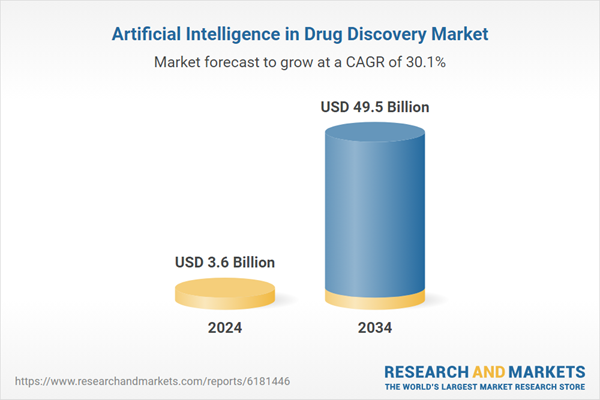This exceptional growth is being driven by the rising incidence of complex and chronic health conditions, combined with increasing interest from pharmaceutical companies in streamlining the drug development process using AI-driven platforms. The demand for faster, more accurate discovery processes is pushing biotech firms and research institutions to integrate advanced technologies like deep learning and predictive analytics into their R&D workflows. Additionally, ongoing innovation in data integration, growing digital infrastructure, and greater awareness among stakeholders are accelerating adoption. Expanding collaboration between AI startups and pharmaceutical manufacturers, particularly in technologically advanced regions, is reshaping how therapeutics are identified and developed, opening new possibilities across the healthcare ecosystem. AI’s role in the drug discovery space involves using sophisticated technologies such as natural language processing, generative algorithms, and deep learning tools to enhance target validation, optimize lead compounds, and support efficient clinical trial planning.
The software segment held 68.1% share in 2024. This dominance is primarily due to widespread adoption during early drug development stages such as compound screening and structure-activity predictions. Software-based AI tools are now integral in providing automation, accuracy, and scalability, meeting the growing demand among pharma companies for efficient R&D workflows. Rapid advancements in core technologies like NLP and neural networks are pushing the boundaries of what software can deliver in precision medicine.
The machine learning segment held a 62.5% share in 2024, owing to its extensive utility across various stages of drug discovery. This segment encompasses supervised and unsupervised learning models along with other ML algorithms. Cloud computing improvements and the availability of open-source frameworks are enabling more flexible, fast, and scalable model training and deployment. Ongoing collaborations between pharmaceutical giants and AI-focused firms continue to spark innovation in model design and accelerate the development of predictive tools and real-time analytics across discovery pipelines.
North America Artificial Intelligence in Drug Discovery Market held 47.6% share in 2024, propelled by strong R&D investments, broad digital infrastructure, and favorable regulatory frameworks supporting AI integration. Government-backed initiatives and regulatory clarity around digital therapeutics are encouraging market growth. Major collaborations between tech firms and pharma companies in the U.S. and Canada are driving progress in the creation of advanced drug discovery solutions and deepening the regional footprint of AI platforms.
Key players in the Global Artificial Intelligence in Drug Discovery Market are Exscientia, BenevolentAI, Orakl Oncology, AVAYL, Atomwise, Aevai Health, Cyclica, Examol, IBM Corporation, NVIDIA Corporation, Microsoft, Insilico Medicine, Deep Genomics, DenovAI Biotech, chAIron, Aureka Biotechnologies, LinkGevity, 9Bio Therapeutics, Helical, Google (DeepMind), and Deargen. To secure a competitive edge in the Global Artificial Intelligence in Drug Discovery Market, companies are focusing on technology innovation, strategic collaborations, and data-driven product development. Leading players are investing in the development of proprietary AI algorithms that enhance target identification, molecule generation, and clinical success rates. Partnerships between biotech startups and pharma leaders are becoming more prevalent, enabling access to large datasets, domain knowledge, and scalable computing resources.
Comprehensive Market Analysis and Forecast
- Industry trends, key growth drivers, challenges, future opportunities, and regulatory landscape
- Competitive landscape with Porter’s Five Forces and PESTEL analysis
- Market size, segmentation, and regional forecasts
- In-depth company profiles, business strategies, financial insights, and SWOT analysis
This product will be delivered within 2-4 business days.
Table of Contents
Companies Mentioned
The companies profiled in this Artificial Intelligence in Drug Discovery market report include:- 9Bio Therapeutics
- Aevai Health
- Atomwise
- Aureka Biotechnologies
- AVAYL
- BenevolentAI
- ChAIron
- Cyclica
- Deargen
- Deep Genomics
- DenovAI Biotech
- Examol
- Exscientia
- Google (DeepMind)
- Helical
- IBM Corporation
- Insilico Medicine
- LinkGevity
- Microsoft
- NVIDIA Corporation
- Orakl Oncology
Table Information
| Report Attribute | Details |
|---|---|
| No. of Pages | 140 |
| Published | October 2025 |
| Forecast Period | 2024 - 2034 |
| Estimated Market Value ( USD | $ 3.6 Billion |
| Forecasted Market Value ( USD | $ 49.5 Billion |
| Compound Annual Growth Rate | 30.1% |
| Regions Covered | Global |
| No. of Companies Mentioned | 22 |









